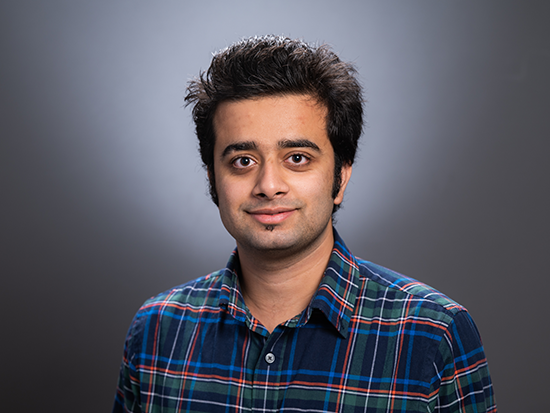Media contact: Alicia Rohan
 Syed RazaWhen Syed Raza enrolled at the University of Alabama at Birmingham in 2019, he entered — as did many students — considering a specific academic path that he thought would be a good fit. Raza had plans to major in computer science in the College of Arts and Sciences, but a conversation with a future academic mentor shifted his direction.
Syed RazaWhen Syed Raza enrolled at the University of Alabama at Birmingham in 2019, he entered — as did many students — considering a specific academic path that he thought would be a good fit. Raza had plans to major in computer science in the College of Arts and Sciences, but a conversation with a future academic mentor shifted his direction.
“I was pretty set on majoring in one area; but I had a conversation with Dr. Renato Camata, who talked about physics in an exciting, dimensional way,” Raza recalled. “As a major and a potential career path, physics was presented in a more attractive way and had more depth than I had imagined. From this conversation, it opened my eyes to being able to mix and match some of my interests like math and computer sciences with physics and enroll in classes that I found of true interest rather than for necessity.”
Opportunities “out of this world”
What began as a conversation with a professor opened doors of opportunity for Raza as a Blazer: He chose to major in physics with a double minor in computer science and mathematics, which was a chance to blend many of his academic interests into a personalized track. He interned in Camata’s lab and was recommended for the University of Alabama in Huntsville and NASA Marshall Space Flight Center Heliophysics Summer Research Opportunity for Undergraduates in summer 2021 because of his exceptional contributions to the lab and physics at UAB.
In this internship, Raza studied what is known as space weather and specifically coronal mass ejections, which are huge explosions in the lower corona — the outer surface of the sun — which then throws that matter into space.
When matter is thrown into space, many of these explosions are directed in line with the Earth; while they likely would not penetrate the Earth’s strong magnetic field, these explosions could severely disrupt or destroy other necessities like satellites that control much of what humans depend on for everyday life or could cause catastrophes like radio blackouts that would have tremendous downstream effects on the planet.
For Raza and others in the field of space weather, being able to predict impact using data mining and physics means that they are at the forefront of keeping Earth protected.
“In this field, we are in the prediction game, and we develop techniques to predict a CME’s arrival time and alert appropriate parties,” Raza explained. “We can’t stop a CME from coming; but using data mining, math and of course physics, we’re able to use calculations and make an impact on something that could severely disrupt daily life. It’s very rewarding.”
With all parts of Raza’s UAB education working together to propel his career in space weather and predictions, he credits the mentorship and collaborative nature of CAS with helping him refine and find his professional passion and be awarded opportunities to thrive and grow as well. His mentor, Renato Camata, Ph.D., associate professor and undergraduate program director in the Department of Physics, agrees.
“Syed’s success builds on his strong work ethic and the smart way he extracted value from the UAB undergraduate experience,” Camata commented. “Syed combined his grounding in physics with undergraduate research and computational fluency. His graduation in the computational physics track of the bachelor’s degree in physics launches him into a promising career in computational science. He has the training to tackle complex problems at the forefront of our most challenging technical fields.”
Pakistan to Birmingham and beyond
Immigrating from Pakistan to Hoover, Alabama, when he was 16, Raza obtained his GED and enrolled at Jefferson State Community College for two years prior to becoming a Blazer. While life in America presented new opportunities, he credits this time in his life with helping him better learn the English language, getting acclimated to student life, and ultimately getting scholarships that helped him enroll and study at UAB.
Now on the cusp of finishing his courses at UAB and starting his Ph.D. in space science at UAH — part of the University of Alabama System — in January 2023, Raza feels as though his career opportunities are endless.
“It’s been my dream job to get my Ph.D., post-doctorate, and become a researcher, and my time at UAB and at UAH will have cemented these opportunities for me,” Raza said. “With potential for work in industry or to stay in academia, the space business is one that keeps growing, and I am excited about continuing my work in solar event prediction.”